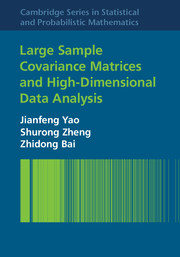Refine search
Actions for selected content:
2348 results in Statistical theory and methods

Large Sample Covariance Matrices and High-Dimensional Data Analysis
-
- Published online:
- 05 April 2015
- Print publication:
- 26 March 2015
-
- Book
- Export citation
Appendix A - Some distributions
-
- Book:
- Core Statistics
- Published online:
- 05 April 2015
- Print publication:
- 02 April 2015, pp 213-218
-
- Chapter
- Export citation
Frontmatter
-
- Book:
- Core Statistics
- Published online:
- 05 April 2015
- Print publication:
- 02 April 2015, pp i-iv
-
- Chapter
- Export citation
Appendix B - Matrix computation
-
- Book:
- Core Statistics
- Published online:
- 05 April 2015
- Print publication:
- 02 April 2015, pp 219-232
-
- Chapter
- Export citation
3 - R
-
- Book:
- Core Statistics
- Published online:
- 05 April 2015
- Print publication:
- 02 April 2015, pp 49-78
-
- Chapter
- Export citation
Preface
-
- Book:
- Core Statistics
- Published online:
- 05 April 2015
- Print publication:
- 02 April 2015, pp viii-viii
-
- Chapter
- Export citation
7 - Linear models
-
- Book:
- Core Statistics
- Published online:
- 05 April 2015
- Print publication:
- 02 April 2015, pp 184-212
-
- Chapter
- Export citation
4 - Theory of maximum likelihood estimation
-
- Book:
- Core Statistics
- Published online:
- 05 April 2015
- Print publication:
- 02 April 2015, pp 79-88
-
- Chapter
- Export citation
1 - Random variables
-
- Book:
- Core Statistics
- Published online:
- 05 April 2015
- Print publication:
- 02 April 2015, pp 1-18
-
- Chapter
- Export citation
Index
-
- Book:
- Core Statistics
- Published online:
- 05 April 2015
- Print publication:
- 02 April 2015, pp 245-250
-
- Chapter
- Export citation
Appendix C - Random number generation
-
- Book:
- Core Statistics
- Published online:
- 05 April 2015
- Print publication:
- 02 April 2015, pp 233-240
-
- Chapter
- Export citation
Contents
-
- Book:
- Core Statistics
- Published online:
- 05 April 2015
- Print publication:
- 02 April 2015, pp v-vii
-
- Chapter
- Export citation
References
-
- Book:
- Core Statistics
- Published online:
- 05 April 2015
- Print publication:
- 02 April 2015, pp 241-244
-
- Chapter
- Export citation
2 - Statistical models and inference
-
- Book:
- Core Statistics
- Published online:
- 05 April 2015
- Print publication:
- 02 April 2015, pp 19-48
-
- Chapter
- Export citation
6 - Bayesian computation
-
- Book:
- Core Statistics
- Published online:
- 05 April 2015
- Print publication:
- 02 April 2015, pp 133-183
-
- Chapter
- Export citation
5 - Numerical maximum likelihood estimation
-
- Book:
- Core Statistics
- Published online:
- 05 April 2015
- Print publication:
- 02 April 2015, pp 89-132
-
- Chapter
- Export citation
6 - Classification of Data
-
- Book:
- Large Sample Covariance Matrices and High-Dimensional Data Analysis
- Published online:
- 05 April 2015
- Print publication:
- 26 March 2015, pp 75-104
-
- Chapter
- Export citation
Frontmatter
-
- Book:
- Large Sample Covariance Matrices and High-Dimensional Data Analysis
- Published online:
- 05 April 2015
- Print publication:
- 26 March 2015, pp i-iv
-
- Chapter
- Export citation
1 - Introduction
-
- Book:
- Large Sample Covariance Matrices and High-Dimensional Data Analysis
- Published online:
- 05 April 2015
- Print publication:
- 26 March 2015, pp 1-6
-
- Chapter
- Export citation
Appendix A - Curvilinear Integrals
-
- Book:
- Large Sample Covariance Matrices and High-Dimensional Data Analysis
- Published online:
- 05 April 2015
- Print publication:
- 26 March 2015, pp 291-298
-
- Chapter
- Export citation
